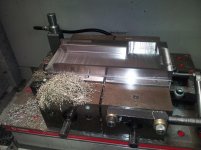Machinerer
Cast Iron
- Joined
- Jun 12, 2009
- Location
- Clearwater, FL
I'm machining some 15-5, H900. HSM toolpath, 485SFM, 8% WOC, varying DOC, from .5 to 2.0, and .002"ipt. Will I have better luck running this with coolant, or air blast? Running on an HMC, so chip evac is no issue.
BTW, it's this endmill -----> Helical Tool
BTW, it's this endmill -----> Helical Tool



